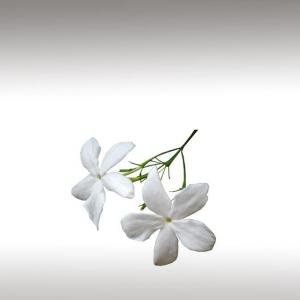
ROYAL JASMINE ESSENTIAL OIL (JASMINUM GRANDIFLORUM) - ESSENTIAL OILS

BASE / GENERAL DATA
Information submited: February 21, 2015 Modified: March 21, 2018 By: OperaDreamhouse
Botanical Name: Jasminum grandiflorum
Common Method of Extraction: Steam Distillation
Part Typically Used: Flowers
Color: Deep brown with a golden tinge
Consistency: Thick
Perfumery Note: Base
Strength of Initial Aroma: Sweet, exotic and richly floral smell
It is widely cultivated as an ornamental plant in warm temperate and subtropical regions. The term Jasmine is probably derived from Persian word Yasmine meaning "Fragrance", which is adopted in Arabic as Yasym given to Jasmine flowers.
Jasminum Grandiflorum, also known variously as the Spanish Jasmine, Royal Jasmine, Catalonian Jasmine, is a species of Jasmine native to South Asia (Nepal, Kashmir, and Northern Pakistan), the Arabian peninsula (Oman, Saudi Arabia), Northeast Africa (Eritrea, Ethiopia, Djibouti, Somalia, Sudan), the African Great Lakes (Kenya, Uganda, Rwanda), and the Yunnan and Sichuan regions of China.
The plant is known as "Saman Pichcha" or "Pichcha" in Sri Lanka. Buddhist and Hindu temples use these flowers in abundance.
It is a scrambling deciduous shrub growing to 2 - 4 m tall. The leaves are opposite, 5 - 12 cm long, pinnate with 5 - 11 leaflets. The flowers are produced in open cymes, the individual flowers are white having corolla with a basal tube 13 - 25 mm long and five lobes 13 - 22 mm long. The flower's fragrance is unique and sweet. The flowers open at night, and close in the morning.
Jasmines are a group of shrubs grown commercially for production of their fragrant flowers and essential oil.
The bulk of the flowers are used as such in garlands and decorative branches for religious offerings, and a small quantity is used for production of oils and attars. Jasmine concrete and absolute are used in high-grade perfumes, and come next to Rose in order of importance.
Since recent times, Jasmine has been concluded as the "King of Oils" (Rose is the "Queen"). Apparently this is because Jasmine is the most masculine of all the floral oils.
It takes eight million Jasmine flowers to create a single kilogram of essential oil, they must be hand-picked before sun-rise, and the essence is skillfully extracted, to give the highest grade of essential oil.
Common Method of Extraction: Steam Distillation
Part Typically Used: Flowers
Color: Deep brown with a golden tinge
Consistency: Thick
Perfumery Note: Base
Strength of Initial Aroma: Sweet, exotic and richly floral smell
It is widely cultivated as an ornamental plant in warm temperate and subtropical regions. The term Jasmine is probably derived from Persian word Yasmine meaning "Fragrance", which is adopted in Arabic as Yasym given to Jasmine flowers.
Jasminum Grandiflorum, also known variously as the Spanish Jasmine, Royal Jasmine, Catalonian Jasmine, is a species of Jasmine native to South Asia (Nepal, Kashmir, and Northern Pakistan), the Arabian peninsula (Oman, Saudi Arabia), Northeast Africa (Eritrea, Ethiopia, Djibouti, Somalia, Sudan), the African Great Lakes (Kenya, Uganda, Rwanda), and the Yunnan and Sichuan regions of China.
The plant is known as "Saman Pichcha" or "Pichcha" in Sri Lanka. Buddhist and Hindu temples use these flowers in abundance.
It is a scrambling deciduous shrub growing to 2 - 4 m tall. The leaves are opposite, 5 - 12 cm long, pinnate with 5 - 11 leaflets. The flowers are produced in open cymes, the individual flowers are white having corolla with a basal tube 13 - 25 mm long and five lobes 13 - 22 mm long. The flower's fragrance is unique and sweet. The flowers open at night, and close in the morning.
Jasmines are a group of shrubs grown commercially for production of their fragrant flowers and essential oil.
The bulk of the flowers are used as such in garlands and decorative branches for religious offerings, and a small quantity is used for production of oils and attars. Jasmine concrete and absolute are used in high-grade perfumes, and come next to Rose in order of importance.
Since recent times, Jasmine has been concluded as the "King of Oils" (Rose is the "Queen"). Apparently this is because Jasmine is the most masculine of all the floral oils.
It takes eight million Jasmine flowers to create a single kilogram of essential oil, they must be hand-picked before sun-rise, and the essence is skillfully extracted, to give the highest grade of essential oil.

SPIRITUAL PRACTISES DATA

MEDICINE / HEALTH DATA

BEAUTY / COSMETICS DATA

FOOD / COOKING DATA
COMMENTS
No comments.
Newest mixtures containing Royal Jasmine Essential Oil (Jasminum Grandiflorum):

Essential Oil for the Second Chakra (The Sacral Chakra - Svadisthana)
February 27, 2015


